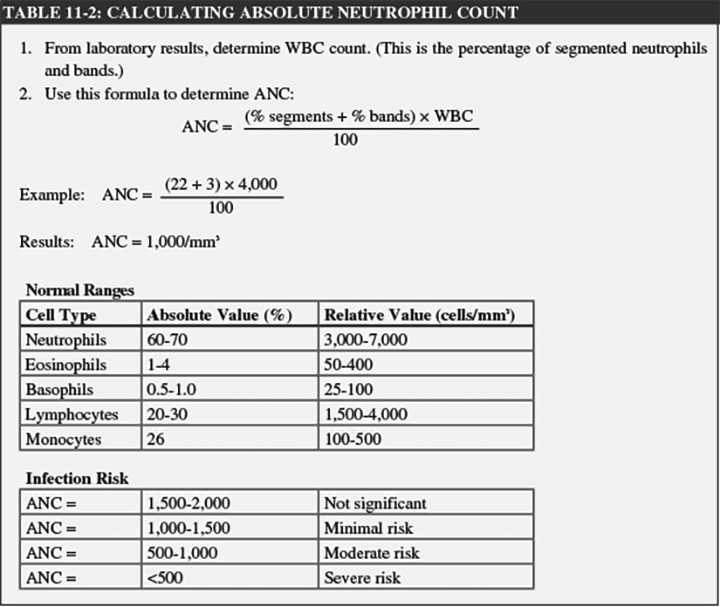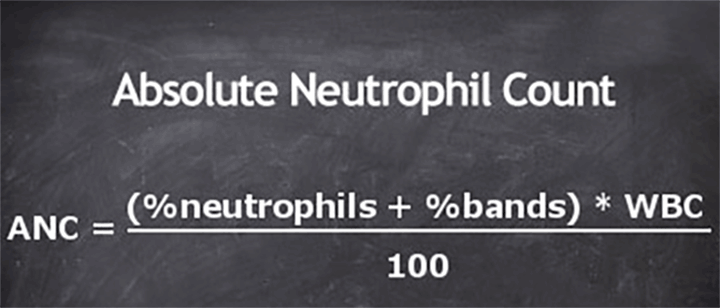While reading progress notes for Martina, a 16-year-old with Hodgkin’s disease, you find out the physician will base the next chemotherapy dose on her absolute neutrophil count (ANC). You’re aware that neutrophils are a type of white blood cell (WBC). You also know the ANC value doesn’t appear separately on the standard laboratory report; usually, it needs to be calculated.
Would you be confident in performing this calculation? Read on to learn about neutrophils, implications of abnormal ANC values, and how to calculate the ANC.
Immunologic role of neutrophils
A routine blood smear identifies the five types of WBCs—neutrophils, lymphocytes, monocytes, eosinophils, and basophils. Neutrophils make up about 55% to 70% of the total WBC count. Their primary function is phagocytosis—a process by which they engulf and digest microorganisms and cell fragments.
Acute bacterial infection and trauma stimulate neutrophil production, which elevates the WBC count. Significant stimulation of neutrophil production causes immature neutrophil forms, called bands or stab cells, to enter the circulation.
Normal and abnormal ANC values
Normally, the ANC exceeds 2,500/mm3. A value above 1,000/mm3 usually means it’s safe to continue chemotherapy. On the other hand, a value below 1,000/mm3 sharply increases the risk of infection. Neutropenia refers to an abnormally low ANC.
Uses of the ANC
Knowing a patient’s ANC has several advantages:
• It reflects the patient’s immunologic status in response to chemotherapy. Myelosuppressive chemotherapy suppresses WBC (and thus neutrophil) production, raising the risk of severe infection. A low ANC may indicate the need to delay the next chemotherapy dose or to reduce the dosage.
• The ANC value helps predict subsequent neutropenic events (such as fever) after the first chemotherapy cycle by providing a more accurate picture of immunologic status than the neutrophil or WBC count alone.
• It helps the physician determine whether to initiate treatment with growth factors, antibiotics, and other protective measures to decrease the risk of neutropenic complications. For example, administering filgrastim (recombinant methionyl human granulocyte colony-stimulating factor) can shorten neutropenia duration and reduce the risk of febrile neutropenia. This in turn increases the chance that full-dose chemotherapy can be given on time.
• For a hospitalized patient, a low ANC may indicate the need for protective isolation to guard against exposure to infection. For an outpatient, it may indicate the need to avoid crowds and people with colds, runny noses, or influenza.
How to calculate ANC
You can calculate your patient’s ANC in one of two ways. (See Calculating ANC in pdf format by clicking on the download now button.)


Protecting neutropenic patients
ANC is an essential monitoring parameter for cancer patients at risk for bone marrow suppression caused by chemotherapy, radiation therapy, or bone marrow transplant. If your patient’s ANC is abnormally low, be sure to practice meticulous hand hygiene—the single most important way to prevent infection in these patients.
Selected references
Pagana K, Pagana T. Mosby’s Diagnostic and Laboratory Test Reference. 8th ed. St. Louis, Mo: Elsevier/Mosby; 2007.
Pagana K, Pagana T. Mosby’s Manual of Diagnostic and Laboratory Tests. 3rd ed. St. Louis, Mo: Elsevier/Mosby; 2006.
Polovich M, White J, Kelleher L, eds. Chemotherapy and Biotherapy Guidelines and Recommendations for Practice. 2nd ed. Pittsburgh, Pa: Oncology Nursing Society; 2005.
Rivera E, Erder M, Fridman M, Frye D, Hortobagyi GN. First-cycle absolute neutrophil count can be used to improve chemotherapy-dose delivery and reduce the risk of febrile neutropenia in patients receiving adjuvant therapy: a validation study. Breast Cancer Res. 2003;5(5): R114-R120.
Kathleen D. Pagana is a keynote speaker and author, President of Pagana Keynotes & Presentations, and Professor Emeritus at Lycoming College in Williamsport, Pa. She is the co-author of 18 books on diagnostic and laboratory testing. For more information about her presentations and books, visit www.KathleenPagana.com.



















3 Comments.
Neutrophils (Absolute) 1.3 L 1.4-7.0
(x10E3/uL) RN
What does this mean
so what does it mean a 14.6*1000/mcl? it seems like double the normal range!
The Absolute neutrophil count is not measured directly. It is derived by multiplying the WBC count times the percent of neutrophils in the differential WBC count. The percent of neutrophils consists the segmented neutrophils + the bands. The normal range for the ANC = 1.5 to 8.0.